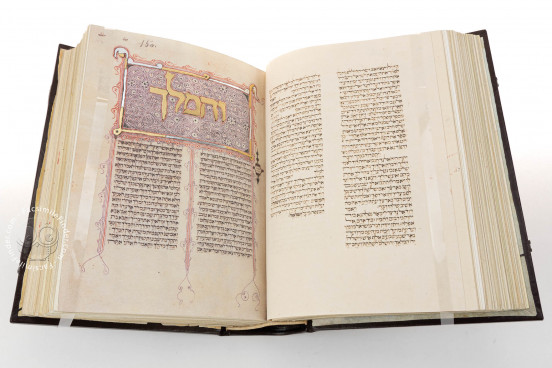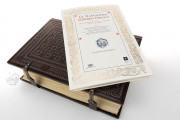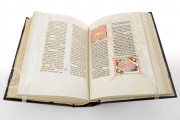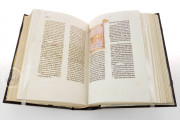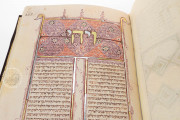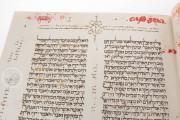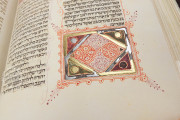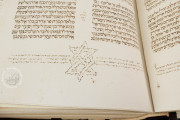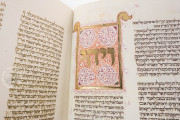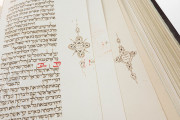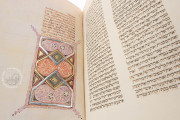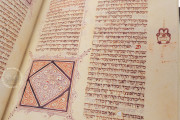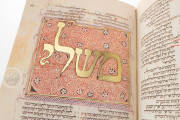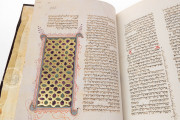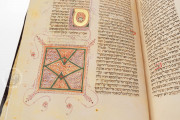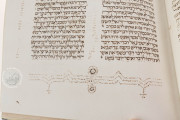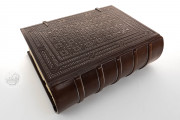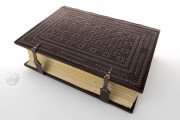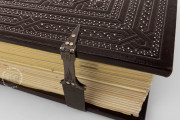The Escorial Hebrew Bible is a complete Tanakh in Hebrew and Aramaic, produced in fifteenth-century Sephardic Spain. It is a deluxe manuscript with a painted carpet page, and painted word panels, headpieces, and tailpieces. Micrography occupies many of the upper and lower margins. Marginalia in red ink attributed to Alfonso de Zamora suggest that the book was used in preparing the Hebrew text for Francisco Jiménez de Cisneros's Complutensian Polyglot Bible. This rare and distinctive manuscript represents a rich object for research, offering first-hand evidence of the shaping of sixteenth-century printed Bibles.
Elaborate Filigree and Calligraphic Ornamentation
Manuscript G.II.8 is distinguished by its elaborate filigree work and calligraphic embellishments, which exemplify the aesthetic sensibilities of fifteenth-century Iberian scriptoria. The avitelado vellum provides a luminous backdrop for the text, enhancing both readability and visual appeal. Of particular note are the punctuations and masoras present in the Pentateuch, with some exceptions (Genesis 17:26–25 and 19). The manuscript’s decorative program, including geometric medallions and labyrinthine motifs, not only reflects the artistic trends of its era but also underscores the devotional and scholarly investment involved in its production.
Elegant and Distinctive Script
The square Spanish lettering of Manuscript G.II.8 exemplifies calligraphic precision and elegance, characteristic of Sephardic scribal traditions. The script’s clarity and visual harmony create a seamless integration between text and ornamentation, resulting in a manuscript that is both a religious artifact and a work of visual art. Its Tiberian vocalization further demonstrates the scribe’s scholarly expertise, facilitating accurate pronunciation and liturgical use.
Single-Scribe Authorship and Later Annotations
The uniformity of the script throughout the codex strongly suggests that a single scribe executed the original text. Variations in writing style appear only in corrections, marginal notes, and annotations, offering insights into the manuscript’s evolving use over time. Notable examples include Nu 28:25 and Canticles 5:12, where secondary hands have added textual corrections.
Additional marginalia, including letters, numbers, and red-ink glosses, indicate that Manuscript G.II.8 may have been employed, along with other Escorial and Complutense codices, for the textual correction of the Complutense Polyglot Bible, commissioned by Cardenal Cisneros in the early sixteenth century. These annotations likely correspond to the work of Alfonso de Zamora, who participated in the preparation of the Cisneros Bible, highlighting the manuscript’s enduring scholarly utility.
Dating and Historical Context
Although G.II.8 lacks a colophon or explicit date, paleographic analysis situates its creation firmly in the fifteenth century. Careful examination of its parchment, script, and Mudéjar binding allows scholars to reconstruct its historical trajectory. Despite the absence of direct historical markers, the codex offers a rich window into Iberian Jewish textual culture, scribal practices, and the transmission of the Hebrew Bible in late medieval Spain.
We have 1 facsimile edition of the manuscript "Escorial Hebrew Bible": Biblia Hebrea facsimile edition, published by Testimonio Compañía Editorial, 1997
Request Info / Price
